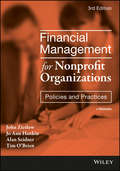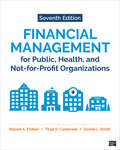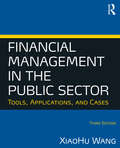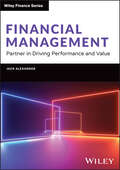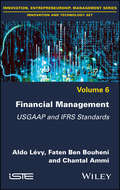- Table View
- List View
Financial Management for Nonprofit Human Service Organizations (Second Edition )
by Raymond Sanchez MayersThis book is an update of the previous edition, formerly titled Financial Management for Nonprofit Human Service Agencies. This new and expanded edition provides the critical knowledge needed to communicate with the "experts." The central organizing theme of this book is the acquisition, distribution, and reporting of agency resources within a systems framework. New topics include fees for services, purchase of service contracting, breakeven analysis for costing services and activities, third-party payments, internet resources, and a glossary.
Financial Management for Nonprofit Organizations
by Jo Ann Hankin John Zietlow Alan G. SeidnerIndispensable for all types and sizes of nonprofit organizations, this important book imparts a clear sense of the technical expertise and proficiency needed as a nonprofit financial officer and includes real-world case studies, checklists, tables, and sample policies to clarify and explain financial concepts.
Financial Management for Nonprofit Organizations: Policies and Practices (Wiley Nonprofit Law, Finance And Management Ser. #109)
by Tim O'Brien Jo Ann Hankin John Zietlow Alan SeidnerEssential tools and guidance for effective nonprofit financial management Financial Management for Nonprofit Organizations provides students, professionals, and board members with a comprehensive reference for the field. Identifying key objectives and exploring current practices, this book offers practical guidance on all major aspects of nonprofit financial management. As nonprofit organizations fall under ever-increasing scrutiny and accountability, this book provides the essential knowledge and tools professional need to maintain a strong financial management system while serving the organization’s stated mission. Financial management, cash flow, and financial sustainability are perennial issues, and this book highlights the concepts, skills, and tools that help organizations address those issues. Clear guidance on analytics, reporting, investing, risk management, and more comprise a singular reference that nonprofit finance and accounting professionals and board members should keep within arm’s reach. Updated to reflect the post-recession reality and outlook for nonprofits, this new edition includes new examples, expanded tax-exempt financing material, and recession analysis that informs strategy going forward. Articulate the proper primary financial objective, target liquidity, and how it ensures financial health and sustainability Understand nonprofit financial practices, processes, and objectives Manage your organization’s resources in the context of its mission Delve into smart investing and risk management best practices Manage liquidity, reporting, cash and operating budgets, debt and other liabilities, IP, legal risk, internal controls and more Craft appropriate financial policies Although the U.S. economy has recovered, recovery has not addressed the systemic and perpetual funding challenges nonprofits face year after year. Despite positive indicators, many organizations remain hampered by pursuit of the wrong primary financial objective, insufficient funding and a lack of investment in long-term sustainability; in this climate, financial managers must stay up-to-date with the latest tools, practices, and regulations in order to serve their organization’s interests. Financial Management for Nonprofit Organizations provides clear, in-depth reference and strategy for navigating the expanding financial management function.
Financial Management for Public, Health, and Not-for-Profit Organizations
by Steven A. Finkler Daniel L. Smith Thad D. CalabreseReflecting recent changes in accounting standards, this Seventh Edition of Financial Management for Public, Health, and Not-for-Profit Organizations provides a comprehensive yet practical introduction to the financial decision-making and management skills required of students and practitioners in the public, health, and not-for-profit sectors. Assuming that readers have no prior training in financial management, the authors artfully combine the principles, theory, and analytics of accounting and finance. In every chapter, a wide range of exercises, case studies, and problems help students develop strong financial assessment and judgment proficiencies while reinforcing the essential mechanics of accounting.
Financial Management for Public, Health, and Not-for-Profit Organizations
by Steven A. Finkler Daniel L. Smith Thad D. CalabreseReflecting recent changes in accounting standards, this Seventh Edition of Financial Management for Public, Health, and Not-for-Profit Organizations provides a comprehensive yet practical introduction to the financial decision-making and management skills required of students and practitioners in the public, health, and not-for-profit sectors. Assuming that readers have no prior training in financial management, the authors artfully combine the principles, theory, and analytics of accounting and finance. In every chapter, a wide range of exercises, case studies, and problems help students develop strong financial assessment and judgment proficiencies while reinforcing the essential mechanics of accounting.
Financial Management for Public, Health, and Not-for-Profit Organizations
by Steven A. Finkler Daniel L. Smith Thad D. CalabreseReflecting recent changes in accounting standards, this Eighth Edition of Financial Management for Public, Health, and Not-for-Profit Organizations provides a comprehensive yet practical introduction to the financial decision-making and management skills required of students and practitioners in the public, health, and not-for-profit sectors. Assuming that readers have no prior training in financial management, the authors artfully combine the principles, theory, and analytics of accounting and finance. In every chapter, a wide range of exercises, case studies, and problems help students develop strong financial assessment and judgment proficiencies while reinforcing the essential mechanics of accounting.
Financial Management for Public, Health, and Not-for-Profit Organizations
by Steven A. Finkler Daniel L. Smith Thad D. CalabreseReflecting recent changes in accounting standards, this Eighth Edition of Financial Management for Public, Health, and Not-for-Profit Organizations provides a comprehensive yet practical introduction to the financial decision-making and management skills required of students and practitioners in the public, health, and not-for-profit sectors. Assuming that readers have no prior training in financial management, the authors artfully combine the principles, theory, and analytics of accounting and finance. In every chapter, a wide range of exercises, case studies, and problems help students develop strong financial assessment and judgment proficiencies while reinforcing the essential mechanics of accounting.
Financial Management for Technology Start-Ups: A Handbook for Growth
by Professor Alnoor BhimaniAll start-up businesses must be founded on product expertise, a grasp of digitisation, and being aware of market forces. Tech start-ups also need a unique understanding of accounting to succeed, knowledge which is required to power their more innovative business models, and the ways of working that drive technology-based businesses. Unlike traditional accounting manuals or those aimed more generally at small business operators, Financial Management for Technology Start-Ups concentrates on what is important in financial terms for technology-based and innovation focused entrepreneurial businesses.Featuring a simple yet effective 'Start-Up Financial Control Loop' and 'Tech Start-Up Tracker,' Financial Management for Technology Start-Ups offers a complete and must-have financial toolkit for launching and managing a tech start-up. The book covers all relevant facets of accounting and finance not covered by any other publication by using straight-forward language, extensive practical illustrations and case studies to demonstrate the financial understanding that has become essential to technology and innovation-based start-ups.
Financial Management for Technology Start-Ups: How to Power Growth, Track Performance and Drive Innovation
by Alnoor BhimaniMore than a third of start-ups fail due to founders having a poor understanding of financial management. Become financially savvy with this easy to understand guide and learn how to effectively grow your business, communicate with investors and progress to the next level.Start-ups face many challenges but managing the finances does not need to be one. Financial Management for Technology Start-Ups offers a complete financial toolkit on how to use this area of your business to your advantage. This book contains invaluable tools and insights designed specifically for tech start-ups, with a concentrated focus on what is important in financial terms for technology-based and innovation focused entrepreneurial businesses.The fully updated second edition offers greater analysis of financial statements directly from real-world start-ups, charts the success of businesses that went from start-up to scale-up with all new case studies and covers new digital technologies, emerging opportunities in the ecosystem, developing markets and much more. For entrepreneurs and tech innovators, this is a must-have book to help take your idea from concept to company with clear and effective financial insights.
Financial Management in Museums: Theory, Practice, and Context
by Rachel Shane Yuha Jung Jaleesa Renee WellsFinancial Management in Museums considers sustainable and innovative solutions to current museum financial challenges by analyzing the many changes and pressures affecting the museum field.Presenting diverse perspectives from a range of authors around the world, the book shares and compares different funding models and methods of museum financial management. Arguing that museums need to be more effective in obtaining and managing financial resources, the volume also demonstrates how innovative and sustainable financial management strategies and structures can allow museums to respond to societal pressures and issues in a more effective way. It also demonstrates that museums must allocate resources responsibly to fulfill their goals of justice, equity, inclusion, and accessibility. The theoretical and practical contributions within the volume cover a comprehensive range of topics, including foundational concepts, revenue, expenses, budgeting, financial leadership, strategic planning, mission-based investment strategies and alternative revenue strategies.Financial Management in Museums focuses on the unique financial needs and structures of museums, while also considering important lessons from adjacent sectors. It will be essential reading for students and academics engaged in the study of museums, arts and cultural management and business. The book will also be useful to museum professionals working around the world.
Financial Management in the Public Sector: Tools, Applications and Cases
by Xiaohu (Shawn) WangThe new edition of this popular book provides a step-by-step guide on how to use financial management and budgeting tools in the public sector. The book features a practical, case-study approach, and includes plentiful exercises and examples. It is designed as a textbook for courses on public financial management or public budgeting that focus on the application of budgeting and financial management tools. Public service professionals will also benefit from this handy primer.
Financial Management in the Sport Industry
by Matthew T. Brown Daniel A. Rascher Mark S. Nagel Chad D. McEvoyNow in a fully revised and updated third edition, this essential textbook introduces the fundamentals of sport finance and sound financial management in the sport industry. It is still the only textbook to explain every aspect of finance from the perspective of the sport management practitioner, explaining key concepts and showing how to apply them in practice in the context of sport. The text begins by covering finance basics and the tools and techniques of financial quantification, using industry examples to apply the principles of financial management to sport. It then goes further, to show how financial management works specifically in the sport industry. Discussions include interpreting financial statements, debt and equity financing, capital budgeting, facility financing, economic impact, risk and return, time value of money, and more. The final part of the book examines financial management in four sectors of the industry: public sector sport, collegiate athletics, professional sport, and international sport. It provides an in-depth analysis of the mechanics of financial management within each of these sport sectors. Useful features, such as sidebars, concept checks, practice problems, case analysis and case questions will help students engage more deeply with financial techniques and encourage problem-solving skills. This new edition includes a completely new chapter on international sport, reflecting the globalized nature of the modern sport industry, as well expanded coverage of current issues such as digital media finance, recent legal cases affecting collegiate sport, and the central importance of collective bargaining. Financial Management in the Sport Industry is an essential textbook for any undergraduate or postgraduate course in sport finance, and an invaluable supplement to any course in sport business or sport management. It is also an important reference for all sport management practitioners looking to improve their understanding of finance. The book is accompanied by updated and expanded ancillary materials, including an instructor’s manual, PowerPoint slides, and an image bank.
Financial Management in the Sport Industry
by Matthew T. Brown Daniel A. Rascher Mark S. Nagel Chad D. McevoyThis book provides readers with an understanding of sport finance and the importance of sound financial management in the sport industry. It begins by covering finance basics and the tools and techniques of financial quantification, using relevant sport examples. It then goes beyond the basics to show how financial management works in the industry--how decisions are made to ensure wealth maximization. Discussions include time value of money, capital budgeting, facility financing, economic impact, and risk and return. The final part of the book focuses on three sport industry sectors--parks and recreation, collegiate athletics, and professional sport--providing in-depth analysis of financial management within each sector. Throughout, sidebars, case studies, concept checks, and financial problems enable thorough study and practice. Readers learn to apply, and see how sport managers apply, sport financial management principles in real-life situations. Altogether, it offers a good balance of first presenting background information on financial management and then spending the majority of its pages focusing on these concepts in a sport-specific context.
Financial Management in the Voluntary Sector: New Challenges (Routledge Studies In The Management Of Voluntary And Non-profit Organizations Ser.)
by Adrian Randall Paul PalmerThe voluntary sector contains over 50,000 organizations, 320,000 paid staff, and 3 million volunteers. The accounting and financial management of organizations in this sector poses as many difficulties as that of major for-profit organizations, if not more so, given the absence of the profit motive upon which much traditional accounting, finance pr
Financial Management of Family Businesses: Transparency – Compliance - Performance – Strategy - Governance (Contributions to Finance and Accounting)
by Thomas Zellweger Patricio OhleFinancial management in family businesses is a special challenge. CFOs in particular are often at the crossroads of various interests and roles. However, not least the public reticence of family businesses has so far ensured that there is a lack of knowledge about these interrelationships. A specialist circle of CFOs from large German-speaking family businesses is dedicated at the Center for Family Business at the University of St.Gallen (Switzerland) to discuss these issues . In this book, these experts share their wealth of knowledge and experience with the public for the first time. Along a five-step model, they shed light on key areas of responsibility that go far beyond mere financial management. They discuss issues of transparency and compliance, from performance and strategy to governance - and provide concrete suggestions for everyday business life. Whether manager, owner, or advisory board member, anyone who bears responsibility in a family business can benefit from this bridge between theory and practice.The CFO network fbxperts.ch has also been present internationally since 3 years: in Italy, Spain, France, UK and other locations.
Financial Management: An Introduction
by Jim McMenaminFinance is a notoriously difficult core subject for business undergraduates, which many find difficult to understand. The area has been dominated by large and complex introductory texts - often from the US - which many lecturers find too detailed and unwieldy.This carefully developed and researched text will fill this gap by providing a succinct, modular, UK-focused introduction to the subject of financial management. Quality controlled by an academic review panel, the content and approach has been rigorously developed to answer the needs of non-finance students.The user-friendly features and design will be of great appeal to the many undergraduates who find finance a difficult subject. Examples, models, formulas, and exercises are lucidly and clearly presented, supported by strong pedagogical features - learning objectives, worked examples, key learning points, further reading, practical assignments, references, case studies and teacher's guide.This ensures that Financial Management will prove the most accessible text for business and finance students.
Financial Management: Bullet Guides
by Philip RamsdenOpen this book and you will Master basic finance Manage balance sheets Budget effectively Foster success
Financial Management: Good Practice Guide
by Brian Pinder-AyresMost newly qualified architects have scant knowledge about the practicalities of running a practice and in particular the challenges of managing the financial side of the business. This book highlights the major financial risks and how these can be avoided.The chapters give straightforward advice and practical solutions based on the author's years of hard-won experience. Friendly, clear and concise, it will give you all the knowledge and tools you need to plan for business success.Based on the original Good Practice Guide, this updated and re-designed version is now even more comprehensive and contains detailed information on fees, as well as real life anecdotal advice from practitioners, updated references, and is in line with the latest legislation. This is invaluable reading for sole and small practitioners of architecture and other creative industries.
Financial Management: Partner in Driving Performance and Value (Wiley Finance)
by Jack AlexanderA comprehensive and insightful approach enabling finance mangers to contribute to business performance and valuation In Financial Management: Partner in Driving Performance and Value, experienced financial executive and consultant Jack Alexander delivers a fresh, new take on improving performance and creating shareholder value for CFOs, controllers, C-suite executives, and FP&A professionals. In the book, you’ll learn about best practices in operational and strategic planning, forecasting, enterprise performance management, business valuation, capital investment, mergers and acquisitions, developing finance talent, supporting growth, and more. Frameworks for dealing with the pace of change and level of uncertainty in today’s environment are also provided, including scenario planning, business agility and monitoring external forces. The book provides actionable insights and practical tools for finance professionals to contribute as trusted advisors and business partners. The author offers free access to financial models in Microsoft Excel and PowerPoint templates on the accompanying website, as well as: Expanded and enhanced content from the author’s widely read previous works Models, illustrations, examples, and dashboards Anecdotes and stories drawn from the author’s 45-year-long career in financial leadershipPerfect for CFOs, controllers, financial executives, financial planning and analysis professionals, and accounting managers, Financial Management is also the ideal desk reference for treasurers, strategic planners, Certified Public Accountants, and equity research analysts. It’s an essential and timely resource for financial leaders everywhere.
Financial Management: Principles and Applications
by John D. Martin Sheridan Titman Arthur KeownIt can often be challenging to see how financial concepts relate to your daily routine and prospective career. Financial Management gives you a big picture perspective of finance and how it’s important in your personal and professional lives. Using 5 key principles, the text weaves in real-world issues to demonstrate the practical applications of critical financial concepts. The 14th Edition has been updated with brand new Personal Applications of Corporate Finance features, study problems, and the latest data and current events.
Financial Management: Theory And Practice (Mindtap Course List)
by Eugene F. Brigham Michael C. EhrhardtAn understanding of finance theory is absolutely essential if students are to develop and implement effective financial strategies. Similarly, students simply must have a working knowledge of the financial environment. FINANCIAL MANAGEMENT: THEORY AND PRACTICE remains the only text in the market that presents a balance of financial theory and applications. <P><P>Authors Brigham and Ehrhardt maintain the same four goals that have made their text a course favorite through each edition: helping learners to make good financial decisions, providing a solid text for the introductory MBA course, motivating learners by demonstrating finance is relevant and interesting, and presenting the material clearly. Plus, with access to CengageNOW for Finance as well as Thomson ONE-Business School Edition, FINANCIAL MANAGEMENT: THEORY AND PRACTICE offers the most comprehensive teaching and learning solution you will find.
Financial Management: Theory and Practice
by Eugene F. Brigham Michael C. EhrhardtGain the understanding of finance you need to make good decisions on the job and advance in your career, whether you work in finance or any other business discipline. Brigham/Ehrhardt’s FINANCIAL MANAGEMENT: THEORY AND PRACTICE, 17E emphasizes key theoretical concepts, equipping you with practical tools for effective decision making. This updated edition focuses on corporate valuation and its importance in financial decisions as you examine the big picture as well as financial details. Chapters connect concepts and tools with fully integrated Excel models that you can apply to typical employment situations. Topics advance from fundamentals to strategic finance, linking recent events to finance in business or your personal life. MindTap online learning platform is also available to reinforce learning. With a relevant presentation, numerous examples and emphasis on Excel applications, this edition provides a comprehensive resource for use throughout your academic and business career.
Financial Management: USGAAP and IFRS Standards
by Chantal Ammi Faten Ben Bouheni Aldo LevyThis book combines the fundamentals of finance with relevance and effectiveness. It allows for the practice of this subject and covers all the programs of business schools, universities' finance courses, and engineering schools. This book is a relevant tool to acquire all the knowledge required for examination success and the achievement of proven practical competences.
Financial Market Analysis and Behaviour: The Adaptive Preference Hypothesis (Routledge Studies in Economic Theory, Method and Philosophy)
by Emil Dinga Camelia Oprean-Stan Cristina-Roxana Tănăsescu Vasile Brătian Gabriela-Mariana IonescuThis book addresses the functioning of financial markets, in particular the financial market model, and modelling. More specifically, the book provides a model of adaptive preference in the financial market, rather than the model of the adaptive financial market, which is mostly based on Popper's objective propensity for the singular, i.e., unrepeatable, event. As a result, the concept of preference, following Simon's theory of satisficing, is developed in a logical way with the goal of supplying a foundation for a robust theory of adaptive preference in financial market behavior. The book offers new insights into financial market logic, and psychology: 1) advocating for the priority of behavior over information - in opposition to traditional financial market theories; 2) constructing the processes of (co)evolution adaptive preference-financial market using the concept of fetal reaction norms - between financial market and adaptive preference; 3) presenting a new typology of information in the financial market, aimed at proving point (1) above, as well as edifying an explicative mechanism of the evolutionary nature and behavior of the (real) financial market; 4) presenting sufficient, and necessary, principles or assumptions for developing a theory of adaptive preference in the financial market; and 5) proposing a new interpretation of the pair genotype-phenotype in the financial market model. The book's distinguishing feature is its research method, which is mainly logically rather than historically or empirically based. As a result, the book is targeted at generating debate about the best and most scientifically beneficial method of approaching, analyzing, and modelling financial markets.
Financial Market Bubbles and Crashes
by Harold L. VogelDespite the thousands of articles and the millions of times that the word 'bubble' has been used in the business press, there still does not appear to be a cohesive theory or persuasive empirical approach with which to study 'bubble' and 'crash' conditions. This book presents a plausible and accessible descriptive theory and empirical approach to the analysis of such financial market conditions. It advances such a framework through application of standard econometric methods to its central idea, which is that financial bubbles reflect urgent short side rationed demand. From this basic idea, an elasticity of variance concept is developed. It is further shown that a behavioral risk premium can probably be measured and related to the standard equity risk premium models in a way that is consistent with conventional theory.


